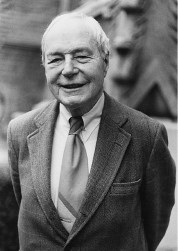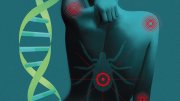Mason Hammond '25, G '32, LL.D. '94, Pope professor of the Latin language and literature emeritus, died on October 13, 2002, four months short of his hundredth birthday. While I could speak of his scholarship here and abroad, and particularly of his adventures as an officer in Italy during World War II, with a roving commission to safeguard antiquities from the perils of Nazi thievery, I shall speak of him instead as a citizenfirst of the University, and then, more intimately, of the University's chapel community.
 |
| Mason Hammond |
| Photograph courtesy of the Harvard University Archives |
Hammond was our last link to the earliest years of the Harvard House system. He was among the bright young men to whom President A. Lawrence Lowell and Professor Julian Lowell Coolidge turned in the late 1920s and early '30s as they began the most radical transformation of Harvard College since its foundingyoung men whose experience and imagination were essential to the enormous task of making a House a home. In his twenty-fifth-reunion report, he wrote:
When President Lowell proposed the House plan, my experience [as a Rhodes Scholar] at Oxford had convinced me of the wisdom of breaking up the amorphous body of undergraduates of our time into smaller units in which the individual, particularly the undistinguished individual like myself, could feel that he had something to contribute and that others were interested in him. The invitation...to be head tutor of one of the first two Houses, Lowell, was accepted with alacrity.
The early archives of Lowell House are animated by the energy and invention of Coolidge and Hammond, who together conspired in the not-uncontroversial introduction of High Table, ridiculed by many at the time as an elitist Oxford intrusion upon Yankee sensibilities; together they also chose the first resident tutors, over whom Hammond presided in the style of a benevolent autocrat. These men were to share in the experiment of intergenerational living through the continuing fellowship of the senior common room.
Although inspired by Oxford, Harvard's House plan was not a pale replica of the English model; the paradox of Lowell, Coolidge, and Hammond, the most Brahmin of trinities, was their determination to make the Houses an experiment in democracy where the experience of social and intellectual diversity could be enjoyed under the most collegial and convivial circumstances. Hammond saw the House plan as an opportunity, explaining in his fiftieth-reunion report:
the student does not lose loyalty to College or class through any loyalty which he may develop to his House; rather his participation in House activities makes him more interested in Harvard as a whole.
Hammond's apprenticeship in Lowell House made him a logical member of the second generation of masters when, in 1946, at the conclusion of his war service, he was asked by President James Bryant Conant to become the third master of Kirkland House. For nearly a decade thereafter, with his friend and colleague, Elliott Perkins '23, Ph.D. '36, in Lowell and his classmate John Finley, Ph.D. '33, L.H.D. '68, in Eliot, Hammond helped secure the House plan as the defining experience of the postwar undergraduate years. While he gave good service to Kirkland House, one always sensed that his first love and enduring passion lay in those early years from 1928 to 1932, when in the formation of Lowell House he, the most junior of instructors, was instrumental in the creation of a great and enduring idea: a House system both human and humane.
This fostering of the House system is no small legacy, but he did much more. For 50 years, from 1936 to 1986, he was the 'Caller' at Commencement, organizing the splendid chaos of the procession with his Boston bray voice, chiding all and sundry to find their places and move on. He was president of the Signet Associates, and as such he presided over the continuity of Harvard's oldest literary society, and over its most radical change, in the early 1970s: the integration of women into that bastion of male letters. Thought to be too conservative for such a daring move, he surprised many, including the undergraduate leadership which had expectedand looked forward toa generational conflict over the matter. They did not know that he was most at home in a house filled with charming, smart women: his wife, Florence, and his three beautiful daughters. (On one occasion, referring to the happiest of marriages, John Finley proposed a toast to his fellow classicist, who "went off to conquer Rome but was in turn conquered by Florence.")
In his long retirement Hammond devoted himself to the history of Harvard, becoming something of our Nestor. He wrote long treatises for the Harvard Library Bulletin on such subjects as the stained glass in Memorial Hall, the Latin and Greek inscriptions on Harvard buildings, the history of the gates and enclosures of the College Yard, and the history of Harvard's ceremonial music. As a long-serving member of the Committee on Seals, Arms, and Diplomasthe "SAD" Committeehe designed the first diploma written in English, abandoning the traditional Latin for undergraduates on the grounds that most of them couldn't read it. He thus provoked the so-called "Diploma Riots," althoughas he later notedPresident Nathan M. Pusey, also a classicist, took more heat than he did.
As a member of the SAD Committee, he also designed the arms of the Memorial Church, the Harvard institution that can claim, perhaps, his longest-sustained attachment. Hammond first began to attend Morning Prayer services in 1921, when he was a freshman, and with a few exceptionsduring the war and leaves of absencehe maintained the habit for 75 years, in a record, we believe, that never has nor ever will be exceeded. Just think of the Morning Prayer talks he endured! In fact, while remarkably charitable in his assessment of what he heardfirst from the back pew, and more recently in the front pewhe was known to have remarked to one of our perennial speakers, who had neglected to shuffle his homiletical barrel, "Almost as good as when you last gave it."
It was at Morning Prayersat the beginning of each morning of each daythat he shone. While rarely in church on Sundays, he gave God six mornings a week of Morning Prayers, including Saturday, for which he was the stalwart of the coffee hour. For many years, in late spring when the flowers were at their best in the gardens of 153 Brattle Street, he and Mrs. Hammond hosted a garden party for chapel-goersbut only for those who had been regular participants. The thought of not being included in that coveted company I am sure stimulated many to improve their attendance in the spring term. Professor Hammond's long presence here led many to think that he was particularly pious or religious. He would always shrug off that assumption: "I am not a holy man," he once said, "but I am a creature of habit, and Morning Prayers is a good habit to cultivate."
We shall not see his like again.
| |
Reverend Peter J. Gomes, B.Div. '68, is Plummer professor of Christian morals and Pusey minister in the Memorial Church.





